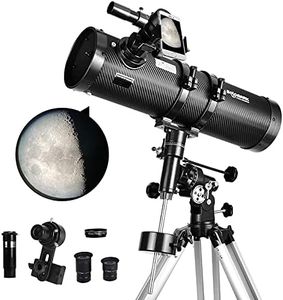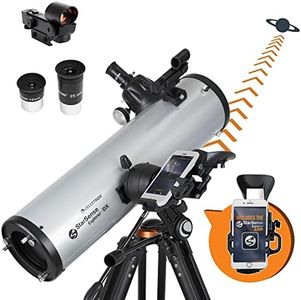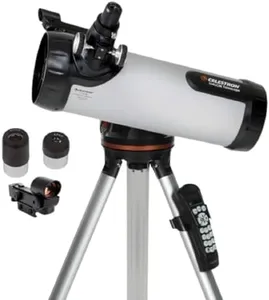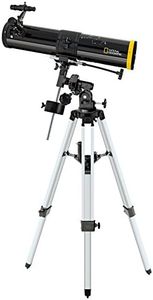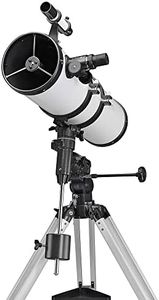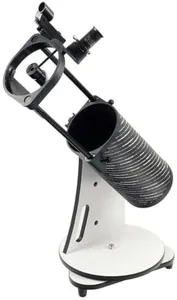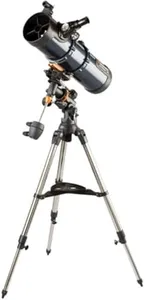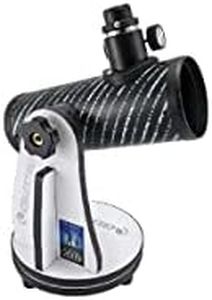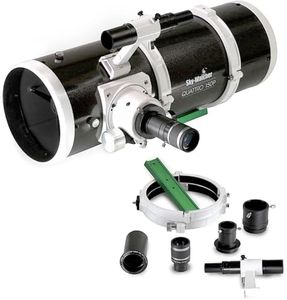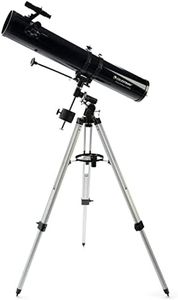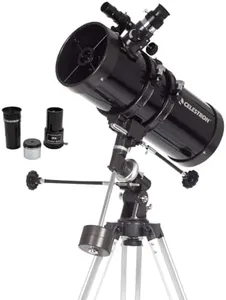We Use CookiesWe use cookies to enhance the security, performance,
functionality and for analytical and promotional activities. By continuing to browse this site you
are agreeing to our privacy policy
10 Best Reflector Telescopes
From leading brands and best sellers available on the web.Buying Guide for the Best Reflector Telescopes
Selecting a reflector telescope is an exciting step into the world of astronomy. These telescopes use mirrors instead of lenses to gather and focus light, making them powerful tools for observing celestial objects. To choose the best reflector telescope for your needs, understanding the key specifications and how they relate to your interests—such as observing planets, deep-sky objects, or both—is essential. By considering factors like aperture size and portability, you can make a confident choice that matches your stargazing ambitions.Aperture (Mirror Diameter)The aperture is the diameter of the main mirror of the telescope, and it’s arguably the most important specification. A larger aperture allows the telescope to collect more light, which translates to brighter and sharper images of distant celestial objects. Aperture sizes commonly range from about 4 inches to 12 inches or more. Smaller apertures (4–6 inches) are lighter and easier to handle, making them good for beginners or those who want something portable. Mid-sized apertures (6–8 inches) offer a balance between performance and manageability, suitable for those wanting better detail of planets and deep-sky objects. Larger apertures (8+ inches) excel in light gathering and are best for serious enthusiasts interested in faint objects, though they are bulkier. Your choice should depend on how much detail you want to see, your willingness to carry heavier equipment, and the kinds of objects you hope to observe.
Focal LengthFocal length is the distance from the mirror to the point where the light is brought into focus. This spec affects both the magnification possibilities and the field of view. Shorter focal lengths provide wider fields of view, which are great for viewing large areas of the night sky (like star clusters or the Milky Way), while longer focal lengths offer higher magnification for viewing planets and the Moon in more detail. Typical reflector telescopes have focal lengths from around 500mm to 1500mm. Think about whether you want broader images or to focus in on individual objects, and choose accordingly.
Focal Ratio (f/number)The focal ratio, written as f/3.9, f/5, f/8, etc., is the focal length divided by the aperture. This ratio influences the brightness of the image and the type of observations best suited to the telescope. Lower focal ratios (f/4–f/5) produce brighter, wider images and are great for deep-sky observations. Higher ratios (f/7–f/8+) are better for planetary or lunar viewing due to their higher magnification and narrower field of view. If you’re interested in general stargazing or photography of large sky regions, choose a lower focal ratio. For detailed planetary observing, a higher focal ratio is preferable.
Mount TypeReflector telescopes come with different types of mounts, which are the structures that support and move the telescope. The most common are Dobsonian (simple, stable, easy to use for beginners and great for large apertures) and equatorial mounts (require more setup but make it easier to track objects as the Earth rotates). Dobsonian mounts are ideal if you want a straightforward, grab-and-go experience, while equatorial mounts suit those interested in longer observation sessions or astrophotography.
Portability and WeightThe size and weight of a reflector telescope affect how easy it is to set up, move, and store. Larger models can be impressive in their views, but they might be challenging to transport and require more storage space. If you plan to observe from different locations or need to carry your telescope up stairs, prioritize a more compact, lighter model. For those setting up in a backyard or permanent location, you might be able to handle a larger, heavier telescope.
Collimation and MaintenanceReflector telescopes require periodic alignment of their mirrors, a process known as collimation. Some designs hold alignment better than others, and larger or faster (low focal ratio) telescopes may need more frequent adjustment. If you prefer a low-maintenance experience, look for models acclaimed for holding their collimation, or make sure you’re comfortable with the process. Collimation isn’t hard to learn but is important for optimal image quality.
